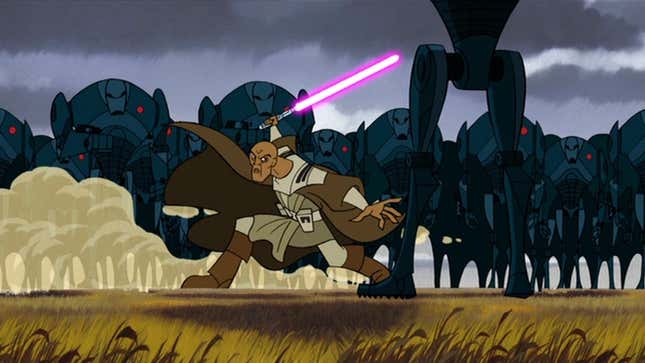Twenty years ago today, the sight of a diminutive cartoon Yoda—shrouded in a hooded cloak, his green lightsaber ignited and held high—riding atop a goatlike mount transformed Star Wars as we knew it. A year before at the climax of Attack of the Clones, he’d told us that begun, the Clone Wars had: now they truly had, and Star Wars would never be the same.
Across two years and 25 chapters, Star Wars: Clone Wars—made for Cartoon Network by the seminal director behind Dexter’s Laboratory, Samurai Jack, and more, Genndy Tartakovsky—brought audiences to the front lines of its titular concept in a way only teased by Attack of the Clones the year before. In doing so, Star Wars unleased a potential it had, at that point, not tapped into in decades: how the power of animation could be used to expand its galaxy, and not just do so cinematically and in terms of its lore, but stylistically as well.
Advertisement

Advertisement
Clone Wars was not necessarily a narrative series—its third season would bring more defined plots and structure that played out over its expanded runtime, but for the most part it was a series of loose vignettes, windows into different fronts of the war. The dialogue was spartan, its stage setting limited. Clone Wars told its story through the beats of its action, the rise and fall of combat. The quiet moments in between the frenzied flurries of blaster bolts and lightsaber swings were exactly that: silence, a tension that sustained everything from elite ARC Troopers slinking through the city streets of Muunilist to the rain-slicked forests of Yavin 4, playing host to a dark duel between Anakin Skywalker and Asaaj Ventress, all the way to the barren wastelands of Hypori as General Grievous made his horrifying debut.
Advertisement
It’s fascinating that Clone Wars—which was, for the most part, almost a stylistic tone piece more than it was a Star Wars story—went on to set the stage for so much of what would follow in the next two decades of the franchise and beyond. Its direct impact on the 3DCG animated series The Clone Wars is, of course, obvious: not just in how the latter show infused the former’s ideas with bigger narrative goals, but in its own influences and stylization, and the perspectives it wanted to tell. The Clone Wars’ spotlight on the personality of the Clone Army can draw a line directly to Clone Wars’ own fascination with the masked legions of the Republic through figures like Captain Fordo, and beyond that in its exploration of a world of Force users outside just the characters of the movies—from Kit Fisto to Luminara Unduli and Bariss Offee, even to its villains in the likes of Asaaj Ventress and Count Dooku.

Advertisement
But perhaps above all Clone Wars’ legacy outside of its direct impact on The Clone Wars—and how that show has gone on to fundamentally reshape so much of contemporary Star Wars fiction through characters like Ahsoka Tano—is how it shaped its audience to be prepared for a world of Star Wars that looked nothing like the movies. That wasn’t the movies. Tartakovsky’s bold-lined, exaggerated art style on Samurai Jack and his other works translated to Star Wars in a fantastic way, giving Clone Wars a feeling that pushed the aesthetic of the Prequel Trilogy even further into its classic, mid-20th-century sci-fi influences, a legacy that we see in the animated projects that came after it even beyond just The Clone Wars, like Rebels and even Star Wars Visions.
That exaggerated aesthetic didn’t just apply visually, but cinematically as well. Clone Wars gave us feats of action the movies never could, Jedi at the apex of their power dismantling swaths of foes in single strikes or mere gestures of their hands—it pushed the boundary of what we could see as acceptably Star Wars-ian to a kind of folkloric mythos. It brought exaggerated tales of how Mace Windu alone could stop the siege of Dantooine, how just 10 Clone Troopers could turn the tide of the Battle of Muunilist, of how just a single cybernetic Separatist General could make a squad of Jedi tremble in fear. Clone Wars’ stylistic presentation lends itself to a blurring between the real and the surreal in ways few Star Wars stories—so obsessed with the rigid definition of what is and isn’t part of a prescribed canon as the franchise can be these days—have since, embracing that idea that there’s always a little truth in legends that would come to define the transition from one era of the Expanded Universe to the next.
Advertisement

Clone Wars arrived at the apex of the Star Wars prequel era, a culmination of ideas George Lucas had had about his story for decades beforehand. But in such a small, impactful way—even supposedly “supplanted” as it would be by a second series to bear its conflict’s name years later—it would go on to influence so much of Star Wars for the decades to come, and keep doing so as the franchise enters an even more culturally saturated era.
Advertisement
Star Wars: Clone Wars is streaming on Disney+.
Want more io9 news? Check out when to expect the latest Marvel, Star Wars, and Star Trek releases, what’s next for the DC Universe on film and TV, and everything you need to know about the future of Doctor Who.
Services Marketplace – Listings, Bookings & Reviews